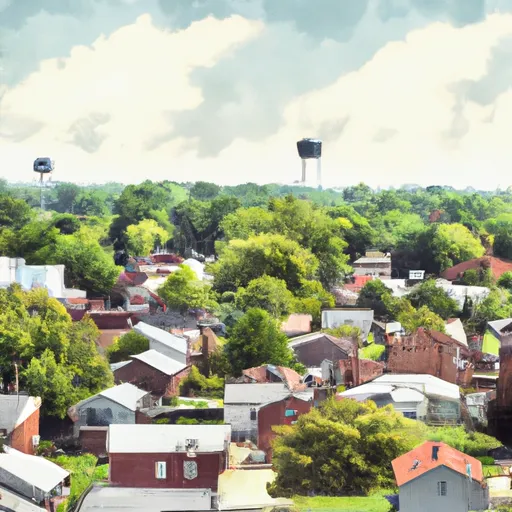-
 Snoflo Premium
Snoflo Premium
Get unlimited access to all our content
With no Ad interruptions! - Start Your Free Trial Login with existing account
Solsberry
Eden Index
Climate
8.1
•
Recreation
2.2
•
Community
•
Safeguard
4.0/10

Solsberry, Indiana is a small rural community located in Greene County. The climate in Solsberry is characterized by warm summers and cold winters. The average annual temperature is around 52°F (11°C), with July being the warmest month and January the coldest. Precipitation is evenly distributed throughout the year, with an average of 43 inches (109 cm) annually.
Hydrology constituents in Solsberry primarily consist of several small creeks and waterways that flow through the area. These include Mill Creek, Clear Creek, and Beech Creek. These water sources provide opportunities for fishing and canoeing.
Outdoor recreation opportunities in Solsberry are abundant. The area is surrounded by picturesque natural landscapes, including forests and rolling hills, making it ideal for hiking and camping. Nearby parks, such as Greene-Sullivan State Forest and Shakamak State Park, offer additional activities such as boating, swimming, and picnicking. Hunting is also popular in the area, with opportunities for deer, turkey, and small game hunting.
Overall, Solsberry, Indiana offers a pleasant climate, beautiful natural surroundings, and various outdoor recreation opportunities for residents and visitors to enjoy.
What is the Eden Index?
The Snoflo Eden Index serves as a comprehensive rating system for regions, evaluating their desirability through a holistic assessment of climate health, outdoor recreation opportunities, and natural disaster risk, acknowledging the profound impact of these factors on livability and well-being.
Climate Health Indicator (CHI): 8.1
Solsberry receives approximately
1193mm of rain per year,
with humidity levels near 81%
and air temperatures averaging around
12°C.
Solsberry has a plant hardyness factor of
6, meaning
plants and agriculture in this region thrive during a short period during spring and early summer. Most
plants will die off during the colder winter months.
By considering the ideal temperature range, reliable water supplies, clean air, and stable seasonal rain or snowpacks, the Climate Health Indicator (CHI) underscores the significance of a healthy climate as the foundation for quality living.
A healthy climate is paramount for ensuring a high quality of life and livability in a region, fostering both physical well-being and environmental harmony. This can be characterized by ideal temperatures, reliable access to water supplies, clean air, and consistent seasonal rain or snowpacks.
Weather Forecast
Streamflow Conditions
Patoka-White
Area Rivers
Patoka-White
Snowpack Depths
Patoka-White
Reservoir Storage Capacity
Patoka-White
Groundwater Levels
Recreational Opportunity Index (ROI): 2.2
The Recreational Opportunity Index (ROI) recognizes the value of outdoor recreational options, such as parks, hiking trails, camping sites, and fishing spots, while acknowledging that climate plays a pivotal role in ensuring the comfort and consistency of these experiences.
Access to outdoor recreational opportunities, encompassing activities such as parks, hiking, camping, and fishing, is crucial for overall well-being, and the climate plays a pivotal role in enabling and enhancing these experiences, ensuring that individuals can engage in nature-based activities comfortably and consistently.
Camping Areas
| Campground | Campsites | Reservations | Toilets | Showers | Elevation |
|---|---|---|---|---|---|
| Henry Horton State Park | 56 | 672 ft | |||
| Newton Stewart State Rec Area - Patoka Lake | 500 | 728 ft | |||
| Seven Points - J. Percy Priest Reservoir | 60 | 521 ft | |||
| Dubois County Park | 32 | 575 ft | |||
| Anderson Road - J. Percy Priest Reservoir | 10 | 535 ft | |||
| West Boggs Park | 220 | 528 ft | |||
| Springs Valley Rec Area | 10 | 672 ft | |||
| Crane MWR Military | None | 594 ft | |||
| Ferdinand State Forest | 70 | 489 ft | |||
| Martin State Forest | 25 | 743 ft |
Nearby Ski Areas
Catastrophe Safeguard Index (CSI):
The Catastrophe Safeguard Index (CSI) recognizes that natural disaster risk, encompassing floods, fires, hurricanes, and tornadoes, can drastically affect safety and the overall appeal of an area.
The level of natural disaster risk in a region significantly affects safety and the overall livability, with climate change amplifying these risks by potentially increasing the frequency and intensity of events like floods, fires, hurricanes, and tornadoes, thereby posing substantial challenges to community resilience and well-being.
Community Resilience Indicator (CRI):
The Community Resilience Indicator (CRI) recognizes that education, healthcare, and socioeconomics are crucial to the well-being of a region. The CRI acknowledges the profound impact of these elements on residents' overall quality of life. By evaluating educational resources, healthcare accessibility, and economic inclusivity, the index captures the essential aspects that contribute to a thriving community, fostering resident satisfaction, equity, and social cohesion.

